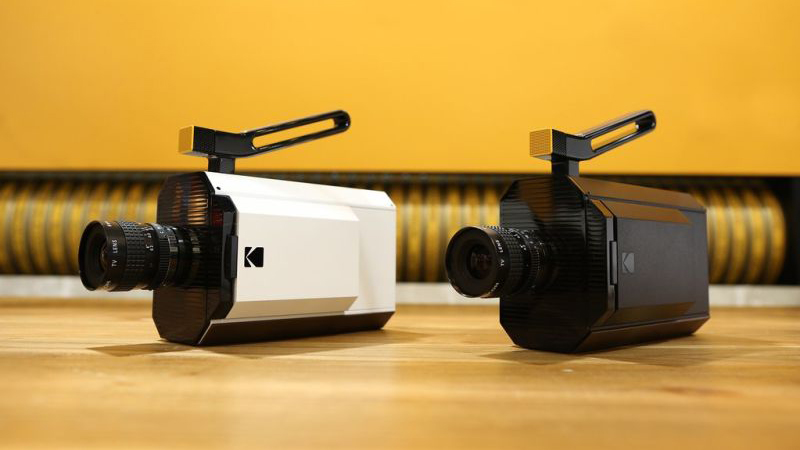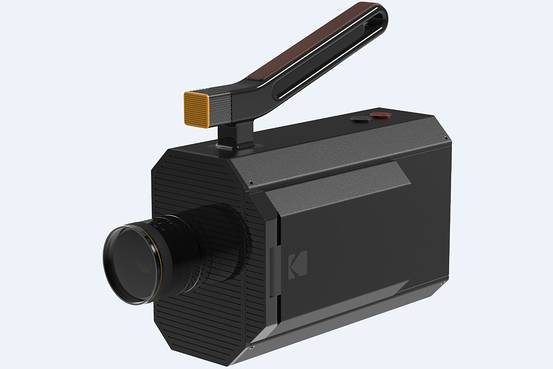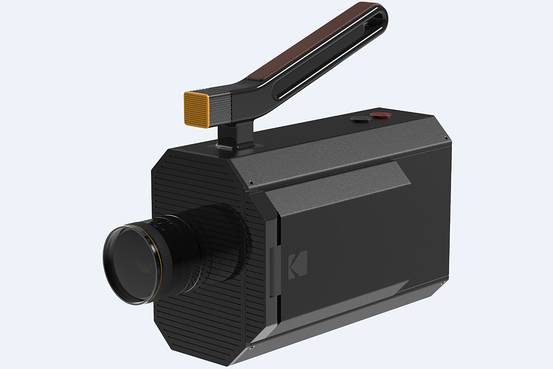-
Gesamte Inhalte
2.929 -
Benutzer seit
-
Letzter Besuch
-
Tagessiege
187
Inhaltstyp
Profile
Forum
Galerie
Alle erstellten Inhalte von Jürgen Lossau
-

Kodak stellt neue Super-8-Kamera vor
Jürgen Lossau antwortete auf Jürgen Lossau's Thema in Schmalfilm
Der Ferrania-Film ist ja auch nicht so recht europäisch. Es ist ein Scotch 3M, Rezeptur aus Amerika. Ich glaube kaum, dass man sich als Schmalfilmer noch mit Fragen der Nationalität oder dem rückgewandten Wir-sind-euch-böse aufhalten kann. Wenn Kodak jemals wieder Umkehrfilm produzieren sollte, werden wir ihn sicher nutzen. Und ob das olle, grobkörnige Scotch-Rezept der Weißheit letzter Schluss ist, sei mal dahingestellt. Ob dann wirklich "europäisch" gekauft wird oder nicht schlichtweg die bessere Qualität das Rennen macht, wird man ja sehen ;). Erst mal muss überhaupt auch nur einer wirklich an den Start gehen - das wäre schon mal schön. Ich sehe gerade - Friedemann hat derweil auch schon rumgeunkt. Ich lasse meins trotzdem stehen :). -

Kodak stellt neue Super-8-Kamera vor
Jürgen Lossau antwortete auf Jürgen Lossau's Thema in Schmalfilm
Sehe ich auch so. -

Kodak stellt neue Super-8-Kamera vor
Jürgen Lossau antwortete auf Jürgen Lossau's Thema in Schmalfilm
Soweit ich weiß, entspricht Max8 aber nicht 16:9. Hat mal jemand das genaue Format von Max8? Es ist im Netz schwer zu finden. Auch Kodak gibt zur neuen Kamera in den Technischen Daten keine genauen Formate des Einzelbilds an. Nach dem Ausmessen eines Max-8-Einzelbilds aus dem Netz komme ich auf ca. 16:10,5. -

Kodak stellt neue Super-8-Kamera vor
Jürgen Lossau antwortete auf Jürgen Lossau's Thema in Schmalfilm
Hallo Helge, da ist du sicher recht. Trotzdem wecken 4k natürlich völlig falsche Erwartungen an das Auflösungsvermögen von Super 8. -

Kodak stellt neue Super-8-Kamera vor
Jürgen Lossau antwortete auf Jürgen Lossau's Thema in Schmalfilm
Man fragt sich (leider) manchmal schon ein bisschen, ob die Damen und Herren bei Kodak genau wissen, wovon Sie reden. Hier ein Zitat aus einem Interview bei engadget mit Danielle Atkins, global director of brand identity, Kodak: What about the ecosystem needed to support the analog camera? The lack of places that can process film has been one of the biggest challenges for anyone trying to shoot on film. D: We're bringing back Kodak consumer products, so we're building a whole package to make it as easy as possible. You buy the camera and the film, shoot it, ship it in an old school yellow envelope, we process it, scan it in 4K and upload it. It's the way Hollywood operates now. They scan to digital. We also send the film back to you in post. So you have the option to [exhibit your work on film] or you can choose to edit the traditional way, too. There's a beauty to projecting film. But, initially we want to make it as accessible as possible. We want to get a whole new generation of filmmakers excited. Providing a digital file and sending the film back is the best of both worlds. Wie soll man denn Negativfilm vorführen? Oder gibt es doch einen Umkehrfilm? Aber davon wird nicht gesprochen... Und warum tastet Kodak in 4K ab, wenn der Super 8 Film nur rund 1K an Informationen enthält? An anderer Stelle wird in dem Interview auch angedeutet, dass Kodak für die Entwicklung und Abtastung in den USA ein neues Labor aufbauen will. Jeff Clarke, Kodak-CEO: What about the ecosystem needed to support the analog camera? The lack of places that can process film has been one of the biggest challenges for anyone trying to shoot on film. J: The ecosystem is critical. Historically the industry was so big that the ecosystem took care of itself, there was a lot of profitability in processing film. Now we realize we need to do that extra bit to make sure that part of the ecosystem is there. So we're doing a significant amount of work for it. For motion picture, fortunately, LA is well positioned. There's FotoKem, one of the best processing labs of motion picture film in the world, and Panavision has a wide variety of film cameras that are available. But in New York, the last [film] processing lab did close down. We worked with Alpha to put a mobile lab in place so movies could be shot in [the city] again. Now we're working on putting a permanent lab back in place. -

Kodak stellt neue Super-8-Kamera vor
Jürgen Lossau antwortete auf Jürgen Lossau's Thema in Schmalfilm
Nachts scheint immer Cox-Umkonstruierzeit zu sein... ;). Die Kamera mit der Einbelichtungsmöglichkeit, die du beschreibst, ist nicht von Fuji, sondern von Agfa. Die Family hat diese Punkte für den Projektor mittels Diode belichtet. Bei einbelichtetem Punkt am Filmrand blieb der Projektor stehen und zeigte nur ein Einzelbild. PS: Wenn Du schon so genaue Vorstellungen von deiner Lieblingskamera hast, solltest du die gesammelten Ergüsse lieber an Kodak direktr schicken. Hier versauern sie wohl eher, denn Kodak wird kaum deutschsprachige Foren lesen... -

Kodak stellt neue Super-8-Kamera vor
Jürgen Lossau antwortete auf Jürgen Lossau's Thema in Schmalfilm
Ruessel - das Objektiv ist, wie die ganze Kamera, ein Dummy. Ob 4k Scan kommt oder sinnvoll ist, steht aber sowieso auf einem anderen Blatt. -

Kodak stellt neue Super-8-Kamera vor
Jürgen Lossau antwortete auf Jürgen Lossau's Thema in Schmalfilm
Also, erstens gibt es ja Bilder, die die Kamera auch mit einem Griff zeigen - vielleicht bekommt der auch einen Auslöser. Und zweitens ist der "Henkel" natürlich für alle Szenen ideal, die in Bodennähe spielen und bei denen man die Kamera tief halten möchte. Das war mit Standard-Super-8-Kameras häufig sehr schwierig. -

Kodak stellt neue Super-8-Kamera vor
Jürgen Lossau antwortete auf Jürgen Lossau's Thema in Schmalfilm
Für die meisten hier aufgeworfenen Fragen ist es noch zu früh. Wie man in den Filmen sehen kann, ist die Kamera bisher ein noch nicht funktionierender Dummy. Wie laut sie ist oder was sie genau kann - das steht alles noch gar nicht fest. Und Martin: Ich bin eher froh, dass da keine Zahntrommel drin ist und mithin für absolut bombigen Bildstand sorgt. Das minimal zittrige des Super-8-Bildes ist einfach Teil des Charmes von Schmalfilm und das gilt es unbedingt zu erhalten. Was die vielen Fragen nach dem Ton angeht: Es ist ja klar, dass Kodak eine neue Zielgruppe im Auge hat, die nichts mit Magnettonrandspur oder Projektion zu tun hat. Die User bekommen nach der Entwicklung ihre Film als Datenfile und legen dann synchron den Ton auf der SD-Karte mittels Schnittprogramm im Rechner an. Danach schneiden sie den Film am Computer. Das ist das Modell, was hier verkauft werden soll. Ob dabei genügend "Charme" des Films übrig bleibt, um die Nutzer dauerhaft von Super 8 (im Gegensatz zu Video) zu überzeugen, bleibt abzuwarten. Es ist von der Idee her eben nicht ganz so retro wie Polaroid/Impossible, Fujifilm Instax oder Lomographie. -

Kodak stellt neue Super-8-Kamera vor
Jürgen Lossau antwortete auf Jürgen Lossau's Thema in Schmalfilm
Ein kleines Video, das die Kameras in der Handhabung zeigt: -

Kodak stellt neue Super-8-Kamera vor
Jürgen Lossau antwortete auf Jürgen Lossau's Thema in Schmalfilm
-

Kodak stellt neue Super-8-Kamera vor
Jürgen Lossau antwortete auf Jürgen Lossau's Thema in Schmalfilm
Wenn es nach den original Kodak-Bildern geht, kommt ja wohl der K40 zurück (siehe Fenster). Ich fürchte allerdings, dass das nur eine kleine Unachtsamkeit der PR-Truppe war...;) -

Kodak stellt neue Super-8-Kamera vor
Jürgen Lossau antwortete auf Jürgen Lossau's Thema in Schmalfilm
Zur Kamera gibt es sogar schon zwei angekündigte C-Mount-Objektive von Ricoh: Technical Specifications FILM FILM GAUGE SUPER 8 ( EXTENDED MAX-8 GATE ) FILM LOAD KODAK CARTRIDGES WITH 50 FT (15 M) SPEED VARIABLE SPEEDS (9, 12, 18, 24, 25 FPS) ALL WITH CRYSTAL SYNC LENS MOUNT C-MOUNT FOCAL LENGTH FIXED / 6 MM, 1:1.2 – RICOH LENS (OPTIONAL ZOOM 6-48 MM LENS ) FOCUS / APERTURE MANUAL FOCUS & IRIS VIEWFINDER VIEW FINDER 3.5" DISPLAY THAT HAS A STANDARD DEFINITION VIDEO INPUT AND SUPPORTS SWIVEL +/- 45 DEGREES EXPOSURE EXPOSURE CONTROL CARTRIDGE DETECTION (SPEED NOTCH) BUILT-IN LIGHT METER FOR SUPPORTED SPEEDS OF ALL KODAK FILM TYPES MANUAL SPEED / MANUAL IRIS SETTING POWER SUPPLY BATTERY & CHARGER INTEGRATED BATTERY AND CHARGER VIA STANDARD USB WALL ADAPTER CONTROL PANEL / SETTINGS CONTROL PANEL VIA VIEWFINDER 3,5" TFT LCD SETTINGS VIA JOG WHEEL AS USER INTERFACE -
Schon auf! ;)
-

Kodak stellt neue Super-8-Kamera vor
Jürgen Lossau antwortete auf Jürgen Lossau's Thema in Schmalfilm
Bilder der neuen Kodak Filmpackung für den 50D Negativfilm und aus Designstudien für die Kodak S-8-Kamera. Links das aufsteckbare Mikro-Modul. -

Kodak stellt neue Super-8-Kamera vor
Jürgen Lossau antwortete auf Jürgen Lossau's Thema in Schmalfilm
Hier ein paar Infos auf deutsch: http://camera-magazin.de/news/kodak-zeigt-neue-super-8-kamera/ -
Hier ein paar Infos auf Deutsch: http://camera-magazin.de/news/kodak-zeigt-neue-super-8-kamera/
-
LAS VEGAS–Eastman Kodak Co., the photography pioneer that was disrupted by the digital revolution, is placing a new bet on a gadget from a simpler time. The company is using the Consumer Electronics Show to lay out plans for a film camera based on the Super 8 design launched 50 years ago. Kodak stopped producing Super 8 units in 1982, after video cameras savaged the market for home movies made with film. Jeff Clarke, Kodak’s chief executive, isn’t ignoring the changes in the market now that billions of consumers own mobile phones with digital cameras. But he believes professional filmmakers and serious amateurs will appreciate the subtle qualities of an analog medium that many Hollywood veterans used to learn their trade. Mr. Clarke cites the preference among many Hollywood directors to shoot on 35-millimeter or 70-millimeter film. He also sees a parallel in the way some audiophiles prefer the analog medium of vinyl records. Kodak plans to play on some of the conveniences of digital technology. Just as movies shot on film are usually converted to digital files for editing and projection, buyers of the new camera that turn to Kodak for processing will get a digital copy of their imagery as well as eight-millimeter film to use in projectors. The new camera will feature a digital viewfinder, he said. “This is no longer the classic script of a war of digital versus analog,” Mr. Clarke said. “What it really is now is the complementary characteristics of both.” Mr. Clarke, a tech industry veteran, is known for stints at companies such as Hewlett-Packard Co.HPQ +0.73%, software maker CA Inc. and the travel technology firm Travelport Inc.TVPT -1.28% He joined Kodak two years ago hoping to lead a turnaround at a company that filed for bankruptcy in 2012 after years of declining sales as consumers flocked to digital cameras. The company emerged from Chapter 11 protection in 2013 and is now meeting financial targets, Mr. Clarke said, deriving most of its revenue these days from printing-related products. But he added that Kodak “is still a company where most of the business is in slow-growing or declining markets.” While shedding many operations, Kodak decided not to exit film altogether. Mr. Clarke, in fact, helped spearhead an effort to seek Hollywood’s help to keep the medium alive. Six major studios agreed in help by purchasing film in sufficient quantity to allow Kodak to keep its film plant in operation. The first Super 8 camera was launched at the 1964 New York World’s Fair and went on sale the next year. It featured a pistol-style grip and packed eight millimeter film in a cartridge, an advance that avoided the need to thread film through the camera in the dark. Kodak’s effort to revive Super 8 is aimed in large part at film schools, where many students no longer get a chance to experiment with analog footage, Mr. Clarke said. He also expects some people making commercial or experimental films–who have sometimes used eight- or 16-millimeter footage–to try the new product. Mr. Clarke said Kodak has received expressions of support for the new camera by many Hollywood directors, including Steven Spielberg and “Star Wars” director J.J. Abrams, who directed a 2011 film called “Super 8″ and was famously hired by Mr. Spielberg as a 14-year-old to work on the older director’s Super 8 film archive. The first new Super 8, expected to arrive in a limited-edition version in the fall of 2016, was conceived with help from the industrial designer Yves Behar. It is likely to cost between $400 to $750, Mr. Clarke estimated. Processing the film should cost $50 to $75 a cartridge, he said. Mr. Clarke expects in 2017 a lower-cost version aimed at a broader audience. CES: J.J. Abrams Backs Kodak’s New Prototype Super 8 Camera J.J. Abrams AP Images/Invision The Super 8 "revival initiative" includes cameras, film development services and postproduction tools. While there will be plenty of digital cameras on display this week at CES, Kodak has selected the venue to debut a prototype of a new Super 8 camera that combines the classic features of a Super 8 film camera with digital functions. Film has been generating a lot of talk in Hollywood recently as the chosen format for high profile movies such as JJ Abrams' Star Wars: The Force Awakens, Quentin Tarantino's The Hateful Eight and Zack Snyder's Batman vs. Superman. Said Abrams in a released statement: "While any technology that allows for visual storytelling must be embraced, nothing beats film. The fact that Kodak is building a brand new Super 8 camera is a dream come true. With a gorgeous new design, interchangeable lenses and a brilliant scheme for development and delivery of footage, this camera appears to be the perfect bridge between the efficiency of the digital world and the warmth and quality of analog.” This camera -- designed in collaboration with Yves Béhar, design entrepreneur and founder of FuseProject -- is part of a Super 8 “revival initiative” aimed at new and established filmmakers, as well as film enthusiasts. Plans for the effort includes cameras, film development services and postproduction tools. “Following the 50th anniversary of Super 8 [in 2015], Kodak is undertaking to re-engage with consumers to provide new opportunities to enjoy and appreciate film as a medium," said Kodak CEO Jeff Clarke.
-
-
Hallo, ich wollte euch darüber informiern, dass in den schmalfilm-Kanal auf Vimeo wieder neue Super-8- und 16-mm-Streifen integriert wurden, die sehenswert sind. Jetzt sind 407 Filme im Kanal, die im nun fast vergangenen Jahr über 5.000-mal aufgerufen wurden. Besonders witzig ist der Trailer aus den späten 70er Jahren, "Super-8-Mania". Aber auch viele neue Streifen sind zu sehen. Hier geht's zum Kanal: https://vimeo.com/channels/schmalfilm Guten Rutsch!
-
Hier der direkte Link zum Film. Wenn man den Baufortschritt sieht, erkennt man, dass es leider noch ein sehr weiter Weg bis zu ersten Filmtests ist. Und bitte nicht vergessen: Erst, wenn die Rezepte für die alte Scotch-Emulsion ausprobiert werden können, beginnt die eigentliche Arbeit... https://vimeo.com/149695033
-
Hallo an alle wackeren Schmalfilmer. Fröhliche Weihnachtsgrüße und hier ein Link zu einem besonders sehenswerten Super-8-Film, der den "Kampf der Systeme" zum Inhalt hat: http://theaudienceawards.com/films/50-feet-that-shook-the-world53135?sh=1450843273szKeV6
-
Hoffen wir, dass Andec davon profitiert. Da sieht es ja auch nicht rosig aus...
-
Was man ausbelichtet hat, kann man doch ganz einfach an anderer Stelle entwickeln lassen - wo immer das noch geht.
-
Sehr geehrte Damen und Herren, liebe Freunde des Hauses ARRI, manche Entscheidungen werden schweren Herzens getroffen, sind aber leider unumgänglich. So müssen wir Ihnen heute mitteilen, dass unser Kopierwerk offiziell zum 31.12.2015 geschlossen wird. Die geringen Umsätze gegenüber den gewaltigen Kosten zwingen uns bedauerlicherweise zu diesem Schritt. Eingestellt werden bei ARRI Media ab 1.1.2016 folgende Arbeiten: Negativ- und Positiventwicklung sämtlicher Formate Negativschnitt Analoge Lichtbestimmung Alle weiteren Dienstleistungen im Zusammenhang mit analogem Film werden aber weiterhin zuverlässig von uns angeboten: · Filmlager · ARRILASER Ausbelichtung 2K/4K auf 35mm Negativ · ARRISCAN 2K/4K von 16/35mm Negativ · Telecine SD/HD · Colourgrading · Filmrestaurierung/Retusche inkl. Negativreinigung









